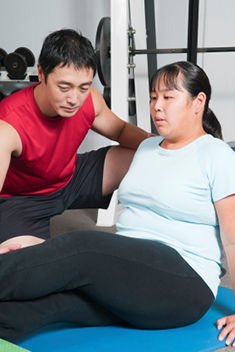
The Truth About Exercise and Appetite

For the past three decades, both experts and laymen have accepted as gospel that exercise is the key to weight loss. People believed that it did so directly, by burning calories, and indirectly, by motivating people to eat more healthfully and reinforcing a feeling of well-being, even moral self-satisfaction.
However, over the past decade or so, one study after another has put chinks in that theory, and we’ve learned that exercise alone—while it confers a plethora of important benefits—doesn’t much affect weight loss. In fact, studies have shown that working out, by increasing the production of ghrelin, a hormone that stimulates appetite, often makes you hungrier.
Dr. Paul Gordon, associate professor and director of the Laboratory for Physical Activity and Exercise Intervention Research at the University of Michigan, sums up the current scientific consensus: “The average person who’s overweight is going to be hard-pressed to expend enough energy and control diet sufficiently using exercise alone. For most people it’s not an effective tool for weight loss.”
However, two recent studies hint that exercise of a certain form and duration has the capacity to change the way our body interacts with food in complex ways that give our appetite the stop sign.
The Research
The first study, which emerged from researchers at the University of Wyoming, Laramie, concluded that intense exercise (in particular, running) might trigger the release of other hormones that affect appetite. Although not yet well understood, these hormones are believed to tell the body when it has sufficiently refueled and can stop eating. The study’s authors concluded that higher levels of these other satiety hormones “muted” the message from ghrelin.

More Funding + More Research = More Obesity Solutions?
Would more solutions to the obesity problem be uncovered if there was more public funding for research?
“In the area of obesity research, we tend to put more money into describing the problem than into studying it. We still do not understand the physiological basis for obesity very well. In fact, one can say that the treatment of obesity is the greatest failure in medicine today.”
Gordon feels that science needs to study weight maintenance over time. “Why do some people stick to their programs and keep the weight off, while others don’t?” Larson agrees: “If we understand why, we can counsel people and tell them, ‘You may feel really hungry after exercise, but eat healthy foods.’”
The Wyoming researchers studied a group of women who either ran or walked and, on alternate days, sat quietly for an hour. Afterwards, the subjects’ were given blood tests, and then taken to a room with a buffet table. The blood tests revealed elevated ghrelin levels in the women who ran, which the researchers expected would cause a hunger-induced stampede toward the buffet, but instead these women consumed several hundred fewer calories than they had expended. The walkers and sedentary groups, however, consumed more calories than they burned.
Based on these findings, the researchers concluded “exercise-induced alterations in appetite are likely driven by complex changes in appetite-regulating hormones.”
The second study, conducted at the Norwegian University of Science and Technology in Tondheim, Norway, revealed that, after about 12 weeks, former couch potatoes who had started a brisk jogging program started to realize—often unconsciously—that overeating was a bad choice. Dr. Catia Martins, who led the study, concluded that exercise, particularly consistent running over several months, "improves the body’s ability to judge the amount of calories consumed and to adjust for that afterward."
Before we go further, a bit of biochemical background is required: Human appetite is an extremely complex mechanism, driven by signals from our brain, fat cells, glands, genes and nervous system. Over the past 15 years, science has uncovered numerous hormones, such as ghrelin, leptin (the long-term appetite-control hormone), the appetite suppressors PYY and POP, obestatin, CCK and glucose insulinotropic peptide (GIP), as well as some newly discovered hormones whose roles remain a mystery.
Each of these appetite-related hormones, such as ghrelin, plays a number of intricate roles in the body. “The actions of ghrelin are extremely complicated,” explains Dr. Catherine Jackson, a professor of exercise physiology at Fresno State University and a fellow of the American College of Sports Medicine. “It does far more than stimulate hunger and, as such, it is difficult to assume one particular effect—such as hunger stimulation—when it can also sequester growth hormone, promote anti-inflammatory processes, enhance memory and learning, and affect sleep and anxiety. The real reason to study this hormone is in obesity; however, we know very little about the obese individual who, in many respects, functions physiologically in the direct opposite way from people of normal weight.”
Dr. Enette Larson-Meyer, an associate professor in the human nutrition and food program at the University of Wyoming, Laramie, and the lead researcher of the first study, acknowledges the challenges her team faced“When people run at high intensity and burn more calories, we’d thought that they’d compensate by eating more, but they ended up with a negative energy balance. This surprised us.
“Our study suggests that, due to blood flow and other factors we haven’t yet discerned, intense exercise is more likely to suppress appetite,” Larson-Meyer continues. “If you look at elite or well-trained athletes, they’re often not hungry. Also, the more you increase intensity, the more you have to divert blood flow to the working muscles from the gut.”
Larson-Meyer adds that the mode of exercise may also affect appetite. “Swimming seems to make people very hungry, running not so much and cycling’s effect is somewhere in the middle.” She conjectures that the effects of swimming may be due to changes in body temperature from being in and out of the water—and those changes may affect appetite. She also suggests that running may reduce hunger by “jarring the gut.”
Larson-Meyer was optimistic that her team’s research could lead to greater discoveries about exercise and appetite regulation.
The Skeptics Speak Up
The experts we spoke to, however, were less than overwhelmed by either study and didn’t agree with the Norwegian researchers’ claim that exercise “improves the body’s ability to judge the amount of calories consumed and to adjust for that afterward.”
While Gordon admits that the Wyoming study was a “first step in looking more closely at exercise modality and hormone regulation,” and suggests that long-term exercise at a certain degree of intensity might regulate appetite, “there are no long-term studies showing that exercise without changes in diet will cause substantial weight loss. All we know now is that if you run for an hour you’ll have a negative energy balance.”
Furthermore, Gordon argues, “Obese people are less inclined to engage in long-term and intense activity,” a charge that even Larson-Meyer admits is valid. “There could be a self-selection bias; the runners could’ve burned more calories because they were thinner and fitter.”

Some experts were skeptical that high-intensity running suppressed appetite. Jackson says that the Wyoming study only proves that appetite is “a complex interaction of multiple factors” and that any links between exercise and hunger also depend on the “predominant metabolic pathway used for energy delivery”—that is, whether the exercise was either aerobic or anaerobic.
She adds that the study results were “far too simplistic.” She notes that the brain is the most powerful regulator of metabolism. “You can ‘fool’ the brain into using less energy by dieting (which often ends up causing weight gain), or you can alter brain function with exercise which, over time, boosts your metabolism.” The bottom line, she says, is that to keep your brain functioning optimally, you should never go on a diet without regular exercise.
As you can see, scientists trying to unlock the secrets of appetite face numerous obstacles due to its daunting complexity. “One can study the effects of a particular hormone in isolation,” explains Jackson, “but when it then interacts chemically with other hormones the results are not always predictable.”
Furthermore, Jackson continues, “The study didn’t measure many other components of blood, such as free-fatty acids, which also would suppress appetite, to see where the confounding variables might have been.”
Dr. Felicia Stoler, dietitian and president of the Greater New York Regional Chapter of ACSM, echoed the other experts in her criticism that the study’s sample size was too small to be significant. She asserts that it involved only women, didn’t provide enough information on the all-female subjects’ ages, nor account for their menstrual cycle/ovulation. (Larson-Meyer agrees that these arguments are valid.) It also failed to track hydration.
Stoler’s basic argument is pragmatic: “At the end of the day, food consumption versus exercise is not just based on hunger. There are many elements, including emotions, food beliefs, and one’s environment. The body doesn't judge calories; our minds do. It is unfair to assume that all people are body aware and would adjust their caloric intake accordingly. What goes on in a lab, despite the researchers’ best efforts, is often not really representative of autonomous individuals.”
Larson-Meyer agrees with our sources that more studies need to be done to substantiate her findings. “As people become better trained, they may need to more finely regulate their food intake. For example, after exercise, a woman may reward herself with a high-calorie treat.”
What All This Means for Your Clients
So what practical advice can you offer your clients should they approach you after having read about these or similar studies or, more likely, hearing about them from a TV sound bite or a friend?
Emphasize that a lot of research on the right combination of exercise and diet still needs to be done, urges Gordon. While considering your clients’ programs and conditioning levels, think about gradually pushing them into higher-intensity exercise as they adjust to being more active. And, says Gordon, “make sure that the regimen is a long-term solution and that your clients are consistent in their routines.”
Finally, Stoler feels that it’s imperative for trainers let their clients know that when they increase their physical activity levels, they may become hungrier. However, “they should choose energy-dense and lower-calorie foods—but not calorie-free foods,” says Stoler. “‘Move more, eat less’ is still the mantra of most science, not just to lose weight, but for overall health, well-being, cardiorespiratory improvements, bone density, immune function and mental health.”

More Articles
- ProSource™: July 2013
ACE-sponsored Study: Hot Yoga—Go Ahead and Turn Up the Heat
- ProSource™: July 2013
New ACSM Guidelines: What Every Fitness Professional Needs to Know
Contributor




 by
by 

